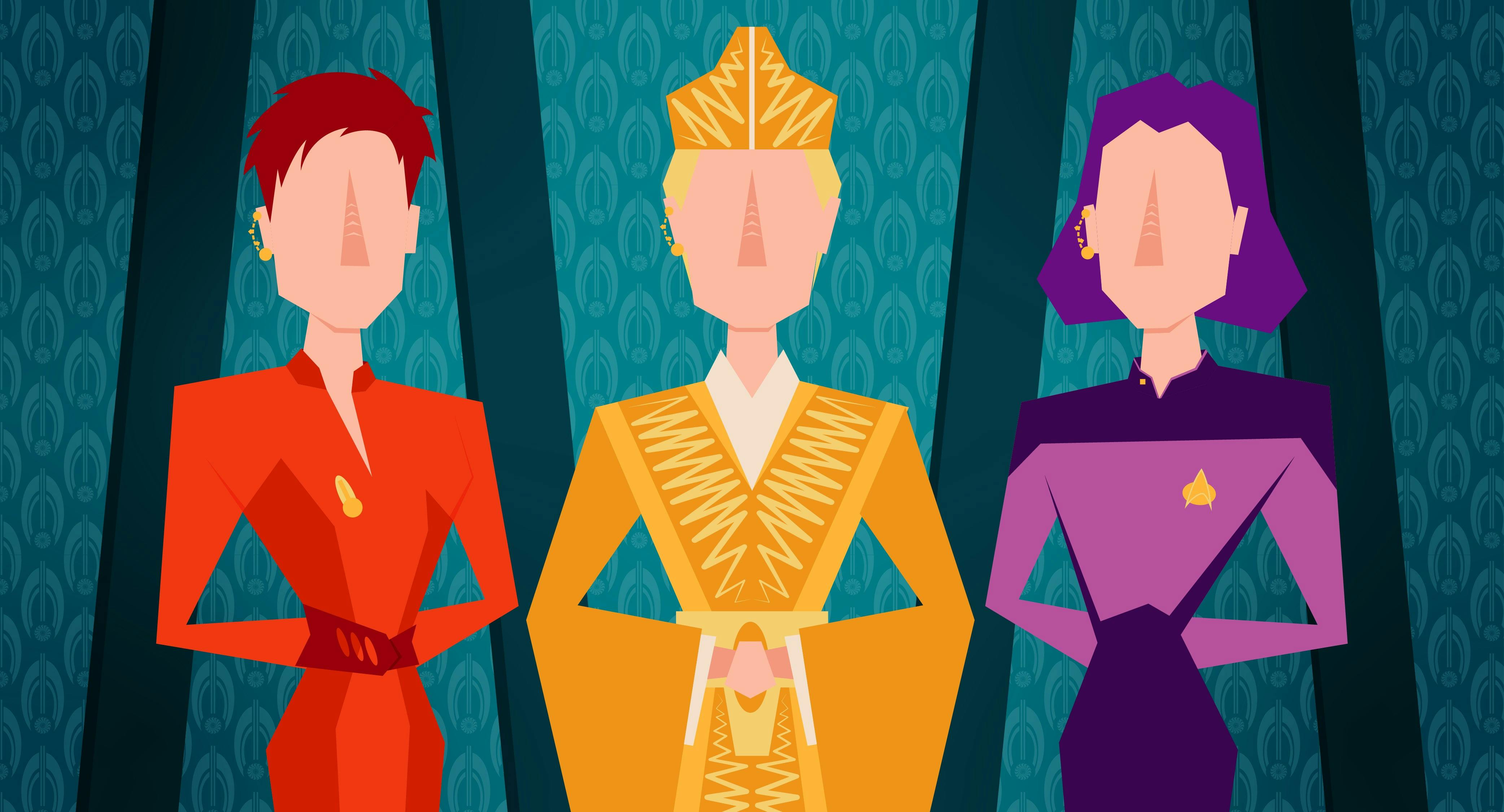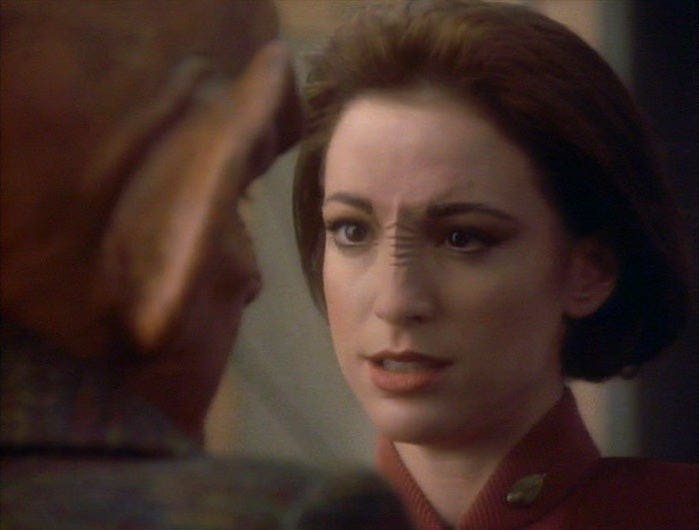Published Jul 26, 2021
Bajoran Culture Is My Feminist and Queer Inspiration
Deep Space Nine shows a culture free from most oppressive power structures.

StarTrek.com
This article was originally published on June 12, 2020
As a kid and teenager watching the original airing of Deep Space Nine, I loved Kira Nerys. She's a well-developed and fascinating character. Plus, with her short hair, no-nonsense demeanor, and unique combination of toughness and emotional depth, Kira wasn’t traditionally feminine from my cultural perspective, and that appealed to me right away.
Through two subsequent full re-watchings of the show, I’ve come to understand how Kira and the other Bajorans we meet show a deeper difference in Bajoran cultural values. In fact, I believe that the Bajoran culture is especially feminist and queer/trans-positive, unmatched by most other species we meet in Star Trek.
Our first introduction to Bajorans is through The Next Generation episode "Ensign Ro” and subsequent episodes featuring Ro Laren. Ro leads with her trademark prickly combativeness, but we also learn how her strength and attitudes stem from her life experiences. She’s a fascinating character, and I admire that she isn’t afraid to make difficult decisions based on her conscience and principles, even when Starfleet leaders disagree.

StarTrek.com
This trait carries over into the lives of other Bajoran women we meet. In the first episode of Deep Space Nine, "Emissary," Major Kira bursts onto the scene with a similar stubbornness and principled nature, snapping at Commander Sisko about commandeering her office. (It was actually originally envisioned that Ro Laren would be the main Bajoran character on the show, but she was relegated to simply appearing in the DS9 post-canon novels.)
People generally respect Kira, even though she isn’t the easiest person to work with, and speaks her mind regardless of consequences. For example, she has zero patience for Quark’s sexism, whereas many people, even other women, just laugh it off. And however you interpret her sexuality, Kira clearly has a full and interesting life with or without her relationships with men.
Leeta is also a brilliant and strong character. As a dabo girl, her job is clearly at least partially about being eye candy for straight men. Although this might cause some people to underestimate her, she’s not ignorant or a pushover. She joins the bar workers’ union, dates and breaks up with Bashir in a thoughtful way, and pushes back on Rom’s sexist ideas of marriage.

StarTrek.com
Bajorans take a variety of roles in their communities. Bajoran women are leaders everywhere, from religious orders to military, resistance, and labor rights organizations. Meanwhile, many Bajoran men are more contemplative. Some are shown not to want leadership for its own sake or to exert power over others (such as Lee Nalas or Bareil Antos). Rarely do we see Bajorans use the basis of gender to comment about anyone's fitness for their work, their relationship status, or anything else. All of this suggests that gender simply doesn't function the same way in Bajoran society as it does in many human societies.
Furthermore, sexual and romantic relationships are handled free of stigma and shame. For example, Kira's relationship with Vedek Bareil (and later, Kai Winn’s relationship with the undercover Gul Dukat) shows that Bajoran religious orders don't place restrictions on their adherents' sexual and romantic relationships. And Kira’s relationships with Shakaar and Odo, as well as Leeta's relationships with Bashir and Rom, show that Bajoran culture is focused on strong loving bonds, appreciation for relationships no matter how short or long, and a lack of sexual stigma.
We can contrast this with the treatment of women in Klingon and Ferengi societies over the years, for example, where women are often openly derided and the culture hasn’t afforded them full rights. On Cardassia, culturally specific gender ideas, such as that women are superior scientists, still persist, while men like Gul Dukat are able to exploit and manipulate women without consequences. And humans are often portrayed as sexist and tokenizing of women, even in this ideal future (see, for example, Harry Mudd, or the way Bashir pursues women in the early seasons of Deep Space Nine).

StarTrek.com
Many Bajoran women are tough and stubborn in ways that are often coded as masculine or queer in my own cultural context, but other Bajorans don’t seem to stigmatize them for it. This indicates to me a society that doesn't think about gender roles like my society does, with no cultural baggage of thousands of years telling women they're less than men.
While I'd certainly love to have seen overt representation of queer and trans Bajorans in Star Trek, the gender equality in Bajoran culture leads me to believe that they live freely and openly, without discrimination, in full equality. It just wouldn't make any sense, not with the demonstrable power of Bajoran women alongside Bajoran men, not in a society where women can speak out against sexism and express their identities freely, and where sexual relationships aren’t stigmatized.
For these reasons and more, Bajoran culture provides inspiration to me. I hope that it’s fodder for all of us to think about what societies without sexism, homophobia, and transphobia might look like.
Erica Leigh (she/her) is a bicycle mechanic, freelance writer, huge Star Trek fan (especially Deep Space Nine and Discovery), and Maquis sympathizer.

